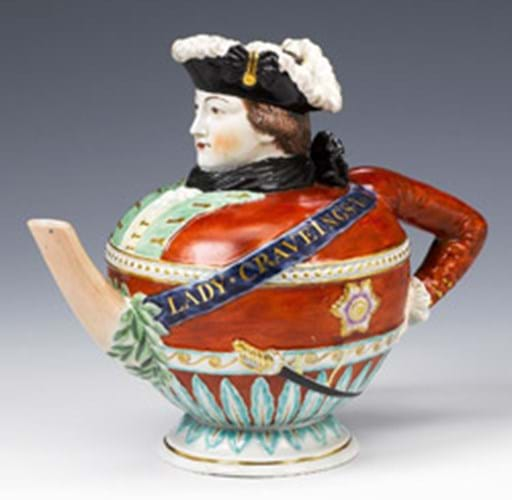
As a socialite with a scandal-packed life, her marriage to Lord William Craven, a cousin of George III, was reportedly punctuated with many affairs including a much publicised liaison with Le Comte de Guines. Many of these dalliances took place at Craven Cottage, her luxurious Thameside retreat now better known as the site of Fulham Football Club.
She separated from her husband in 1780 and, tiring of her affairs, Lord Craven banished her to France three years later. She spent eight years in exile travelling through Europe and the Crimea and formed a new relationship with the Margrave of Anspach, a nephew to Frederick the Great and Queen Caroline of England. She devoted much time petitioning on the Margrave's behalf for him to obtain the blue ribbon of the Order of the Garter.
When Lord Craven died in 1791, the couple returned to England, married and set up in some style at Brandenburg House in Hammersmith as the Margrave and Margravine of Anspach.
Although much of society gave them the cold shoulder, Elizabeth then resumed her interest as a playwright - an activity she dabbled in before her exile but now conducted from a theatre built alongside her own house. Her theatre-opening in April 1793, followed by a lavish masquerade ball, was attended by the Prince of Wales and Duke of Clarence and accompanied by a supply of outrageous costumes from the Margravine.
The Margrave's finances were stretched to match this lavish lifestyle. After his death in 1806, his wife returned to the Continent, settling in Naples. There she died, at Craven Villa, in 1828.
Many aspects of this colourful life are reflected in the extraordinary 6 1/2in (16.5cm) high late 18th century teapot which came up for sale at Bonhams on April 8.
The teapot first appeared for sale on the open market in 1875 at Sotheby's when it was purchased by the then Earl of Craven, and his descendants sold it a century later at Christie's in 1979.
The choice of the teapot shape appears to be a reference to one of Elizabeth Craven's earliest theatrical endeavours The Sleep Walker of 1778 which mentions a character shaped like a teapot in the prologue. The play is quoted on one side of the blue ribbon swathed around the character's ample form along with the additional inscription Performed at Newbury, Written by Lady C.
But plainly there are other more ribald allusions. The other side of the ribbon is punningly emblazoned in bold letters Lady Craveing's Teapot, surely no casual misspelling of her name. The prominent flesh-coloured spout rising up from the lower body of the teapot hints at further double entendres, while the choice of a teapot could also refer to her notorious tea parties at Craven Cottage.
According to Bonhams, the piece has long been held to be a likeness of Lady Craven, although why she should be wearing an officer's uniform is not clear. One suggestion is that this refers to her travelling companion Henry Vernon. But, given the prominence of the blue garter, could an alternative suggestion be that the pot portrays her lover/husband the Margave of Anspach? Or alternatively could it be an amalgam of the couple?
Whatever the decoding, one cannot help but wonder for whom this piece was made and who produced it.
It has no direct parallel in 18th century English porcelain (the nearest is perhaps the much later small group of Royal Worcester teapots satirising the aesthetic dandy of Gilbert and Sullivan's opera Patience). This example is more like a three dimensional version of a satirical cartoon by Gillray or Rowandson and could have been a special commission.
Of course there is no accounting for taste, especially when viewed through the lens of a 200 year gap, but it hardly seems likely to have been commissioned by a friend or admirer of Lady Craven.
As to manufacture, with a late 18th century dating (partly on style, partly on its relation to Lady Craven's life story) the consensus is that the most likely candidate is Derby. It was catalogued as such by Christie's in 1979.
To some extent though, the factory is not of prime importance any more than the condition (it has restored cracks and breaks to the cover, body and base). The interest here lies in the teapot as a seemingly unique slice of social history.
How does one value such an object? Bonhams opted for a guide of £5000-8000 but the final price would surely be anyone's guess. In the event it fetched £19,000 (plus 20 per cent buyer's premium) with several London dealers in the room outpaced by a telephone bidder.
A museum is one obvious candidate for such a piece but there was also much post sale trade speculation that the buyer could be Rosalie Sharp.
As a known collector of teapots and author of Ceramics, Ethics and Scandal, which looks at the 18th century through the ceramics of the period, Lady Craven's teapot could well have been on her shopping list.
By Anne Crane




